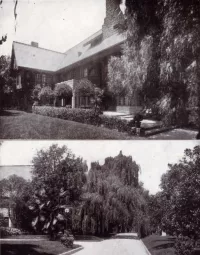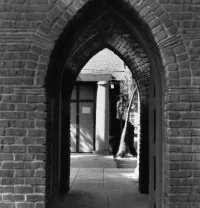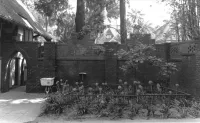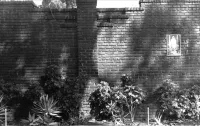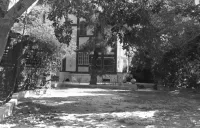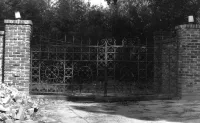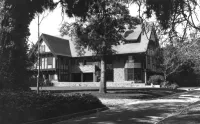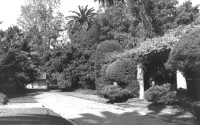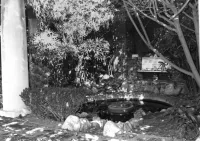Share what you know,
and discover more.
Share what you know,
and discover more.
May 18, 2008
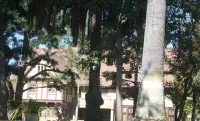
-

- Charmaine Bantugan
Ramsay-Durfee Estate
The Ramsay-Durfee Estate, also known as Durfee Mansion, Durfee House or Villa Maria, is a historic Tudor Revival style mansion on Western Avenue in Los Angeles, California. It has been designated a Los Angeles Historic-Cultural Monument and listed on the National Register of Historic Places. Architecture Completed in 1908, the three-story, 42-room mansion was designed by Frederick Louis Roehrig. Roehrig also planned the landscape gardens and layout of the grounds. The mansion is located on a 2.8-acre (1.1 ha) site that also includes a formal garden and carriage house with chauffeur's quarters. When the house was completed, the Los Angeles Times published a full-page article accompanied by numerous photographs. The Times called it "among the finest homes in Los Angeles" and one of architect Roehrig's "best efforts." The Times described the exterior of the mansion as follows: The house is distinctly of the typical English domestic architecture. The exterior is of stone and half timber and plaster finish, while the roof is of slate. It is probably the finest example of the purely English type of dwelling in this city. The Times also made note of the grand staircase describing it as "the stair builder's art in mahogany" lit by a large group of art glass windows.[3] The third floor was almost entirely taken up by a 25-foot (7.6 m) by 99-foot (30 m) ballroom with a large brick fireplace and an open truss and exposed beam ceilings. History The house was built for a wealthy lumberman, William E. Ramsay, who died in 1909—shortly after the mansion was completed. His widow continued to live in the mansion until her death in 1916. In 1913 the house was featured across six pages in Homes and Gardens of the Pacific Coast Volume II, a picture book of Los Angeles mansions describing it as a "beautiful home of the English style of domestic architecture, designed by Mr. F. L. Roehrig ..." In the early 1920s, the property was purchased for the unheard of price of $105,000 by William G. and Nellie McGaughey Durfee. Mr. Durfee was a horse-racing devotee, and Mrs. Durfee was the sheltered daughter of a Figueroa Street millionaire. Their marriage had been a scandal reported on in the newspapers, as Mr. Durfee had divorced the mother of his two children in 1910 and married Nellie in 1911. During the 1920s, the house was a gathering place for the motion picture business, and its grand staircase and ornately paneled rooms were popular filming locations. Mr. Durfee died in 1927, reportedly from food poisoning while on a fishing trip in the Pacific Northwest. Nellie remained at the house until her death in 1976, reportedly living as a recluse. Columnist Jack Smith toured the Durfee residence in 1976 and found the house virtually unchanged from the time of Mr. Durfee's death 50 years earlier. Though Mr. Durfee had died during Prohibition, the wine cellar remained untouched and full of vintage wines dating to the 1890s and 1900s as well as 183 bottles of vintage whisky. Mr. Durfee's wide-brimmed felt hats and tweed suits were still hanging in his closet. Smith noted that Mrs. Durfee died at age 99, "wasted and blind," in an upstairs bedroom -- "alone with her companion-housekeeper, her cat, her ostrich feathers, her unopened boxes of silk stockings, her sculptures and paintings and Oriental rugs." In 1978, the Brothers of St. John of God bought the property from the Estate of Nellie Durfee for $470,000. The purchaser was a Roman Catholic religious order that operated 260 hospitals which purchased the property to serve as its western headquarters. In 1982, the house was opened to the public for the first time in its history for a benefit dinner to support KUSC radio. Historic designation In 1980 city's Cultural Heritage Commission designated the property, under the name "Villa Maria", as a Los Angeles Historic-Cultural Monument, calling it, "a distinguished example of Tudor Revival architecture of the early 20th Century." It was also listed on the National Register of Historic Places in 1989.
Ramsay-Durfee Estate
The Ramsay-Durfee Estate, also known as Durfee Mansion, Durfee House or Villa Maria, is a historic Tudor Revival style mansion on Western Avenue in Los Angeles, California. It has been designated a Los Angeles Historic-Cultural Monument and listed on the National Register of Historic Places. Architecture Completed in 1908, the three-story, 42-room mansion was designed by Frederick Louis Roehrig. Roehrig also planned the landscape gardens and layout of the grounds. The mansion is located on a 2.8-acre (1.1 ha) site that also includes a formal garden and carriage house with chauffeur's quarters. When the house was completed, the Los Angeles Times published a full-page article accompanied by numerous photographs. The Times called it "among the finest homes in Los Angeles" and one of architect Roehrig's "best efforts." The Times described the exterior of the mansion as follows: The house is distinctly of the typical English domestic architecture. The exterior is of stone and half timber and plaster finish, while the roof is of slate. It is probably the finest example of the purely English type of dwelling in this city. The Times also made note of the grand staircase describing it as "the stair builder's art in mahogany" lit by a large group of art glass windows.[3] The third floor was almost entirely taken up by a 25-foot (7.6 m) by 99-foot (30 m) ballroom with a large brick fireplace and an open truss and exposed beam ceilings. History The house was built for a wealthy lumberman, William E. Ramsay, who died in 1909—shortly after the mansion was completed. His widow continued to live in the mansion until her death in 1916. In 1913 the house was featured across six pages in Homes and Gardens of the Pacific Coast Volume II, a picture book of Los Angeles mansions describing it as a "beautiful home of the English style of domestic architecture, designed by Mr. F. L. Roehrig ..." In the early 1920s, the property was purchased for the unheard of price of $105,000 by William G. and Nellie McGaughey Durfee. Mr. Durfee was a horse-racing devotee, and Mrs. Durfee was the sheltered daughter of a Figueroa Street millionaire. Their marriage had been a scandal reported on in the newspapers, as Mr. Durfee had divorced the mother of his two children in 1910 and married Nellie in 1911. During the 1920s, the house was a gathering place for the motion picture business, and its grand staircase and ornately paneled rooms were popular filming locations. Mr. Durfee died in 1927, reportedly from food poisoning while on a fishing trip in the Pacific Northwest. Nellie remained at the house until her death in 1976, reportedly living as a recluse. Columnist Jack Smith toured the Durfee residence in 1976 and found the house virtually unchanged from the time of Mr. Durfee's death 50 years earlier. Though Mr. Durfee had died during Prohibition, the wine cellar remained untouched and full of vintage wines dating to the 1890s and 1900s as well as 183 bottles of vintage whisky. Mr. Durfee's wide-brimmed felt hats and tweed suits were still hanging in his closet. Smith noted that Mrs. Durfee died at age 99, "wasted and blind," in an upstairs bedroom -- "alone with her companion-housekeeper, her cat, her ostrich feathers, her unopened boxes of silk stockings, her sculptures and paintings and Oriental rugs." In 1978, the Brothers of St. John of God bought the property from the Estate of Nellie Durfee for $470,000. The purchaser was a Roman Catholic religious order that operated 260 hospitals which purchased the property to serve as its western headquarters. In 1982, the house was opened to the public for the first time in its history for a benefit dinner to support KUSC radio. Historic designation In 1980 city's Cultural Heritage Commission designated the property, under the name "Villa Maria", as a Los Angeles Historic-Cultural Monument, calling it, "a distinguished example of Tudor Revival architecture of the early 20th Century." It was also listed on the National Register of Historic Places in 1989.
May 18, 2008
Ramsay-Durfee Estate
The Ramsay-Durfee Estate, also known as Durfee Mansion, Durfee House or Villa Maria, is a historic Tudor Revival style mansion on Western Avenue in Los Angeles, California. It has been designated a Los Angeles Historic-Cultural Monument and listed on the National Register of Historic Places.Architecture
Completed in 1908, the three-story, 42-room mansion was designed by Frederick Louis Roehrig. Roehrig also planned the landscape gardens and layout of the grounds. The mansion is located on a 2.8-acre (1.1 ha) site that also includes a formal garden and carriage house with chauffeur's quarters. When the house was completed, the Los Angeles Times published a full-page article accompanied by numerous photographs. The Times called it "among the finest homes in Los Angeles" and one of architect Roehrig's "best efforts." The Times described the exterior of the mansion as follows:
The house is distinctly of the typical English domestic architecture. The exterior is of stone and half timber and plaster finish, while the roof is of slate. It is probably the finest example of the purely English type of dwelling in this city.
The Times also made note of the grand staircase describing it as "the stair builder's art in mahogany" lit by a large group of art glass windows.[3] The third floor was almost entirely taken up by a 25-foot (7.6 m) by 99-foot (30 m) ballroom with a large brick fireplace and an open truss and exposed beam ceilings.
History
The house was built for a wealthy lumberman, William E. Ramsay, who died in 1909—shortly after the mansion was completed. His widow continued to live in the mansion until her death in 1916. In 1913 the house was featured across six pages in Homes and Gardens of the Pacific Coast Volume II, a picture book of Los Angeles mansions describing it as a "beautiful home of the English style of domestic architecture, designed by Mr. F. L. Roehrig ..."
In the early 1920s, the property was purchased for the unheard of price of $105,000 by William G. and Nellie McGaughey Durfee. Mr. Durfee was a horse-racing devotee, and Mrs. Durfee was the sheltered daughter of a Figueroa Street millionaire. Their marriage had been a scandal reported on in the newspapers, as Mr. Durfee had divorced the mother of his two children in 1910 and married Nellie in 1911. During the 1920s, the house was a gathering place for the motion picture business, and its grand staircase and ornately paneled rooms were popular filming locations. Mr. Durfee died in 1927, reportedly from food poisoning while on a fishing trip in the Pacific Northwest. Nellie remained at the house until her death in 1976, reportedly living as a recluse. Columnist Jack Smith toured the Durfee residence in 1976 and found the house virtually unchanged from the time of Mr. Durfee's death 50 years earlier. Though Mr. Durfee had died during Prohibition, the wine cellar remained untouched and full of vintage wines dating to the 1890s and 1900s as well as 183 bottles of vintage whisky. Mr. Durfee's wide-brimmed felt hats and tweed suits were still hanging in his closet. Smith noted that Mrs. Durfee died at age 99, "wasted and blind," in an upstairs bedroom -- "alone with her companion-housekeeper, her cat, her ostrich feathers, her unopened boxes of silk stockings, her sculptures and paintings and Oriental rugs."
In 1978, the Brothers of St. John of God bought the property from the Estate of Nellie Durfee for $470,000. The purchaser was a Roman Catholic religious order that operated 260 hospitals which purchased the property to serve as its western headquarters. In 1982, the house was opened to the public for the first time in its history for a benefit dinner to support KUSC radio.
Historic designation
In 1980 city's Cultural Heritage Commission designated the property, under the name "Villa Maria", as a Los Angeles Historic-Cultural Monument, calling it, "a distinguished example of Tudor Revival architecture of the early 20th Century." It was also listed on the National Register of Historic Places in 1989.
Posted Date
Sep 19, 2022
Historical Record Date
May 18, 2008
Source Name
Wikipedia
Source Website
Delete Story
Are you sure you want to delete this story?
Jul 24, 1989
Jul 24, 1989
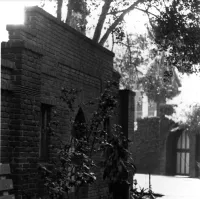
-

- Charmaine Bantugan
National Register of Historic Places - Ramsay-Durfee Estate
Statement of Significance: The Ramsay-Durfee Estate is significant under National Register Criterion "C" because it represents the work of a master, namely, Architect Frederick Louis Roehrig. It is also of interest because (although significance is not claimed for the fact that) it represents the first full flowering of the development of the West Adams residential district of the City of Los Angeles as an area selected by the wealthy for the construction of substantial, architect-designed homes, and because the residence on the estate, which, together with its surrounding landscaping and outbuildings, is substantially intact as designed by Roehrig, represents an early 20th century interpretation of the Tudor Revival architectural style. HISTORIC CONTEXT: The context for the Ramsay-Durfee Estate includes the historical context of the development of the West Adams residential district of the City of Los Angeles, and the architectural context of the development of the Tudor Revival architectural style in the early twentieth 20th century and the career of Architect Frederick Louis Roehrig. The West Adams district developed soon after the turn of the century as a prime residential neighborhood. Several factors contributed to this. First, the next preceding prime neighborhood had been the area just north of the University of Southern California, including Chester Place, a gated subdivision, and St. James Park immediately to the west. West Adams had several attractions as the next prime neighborhood: it lay little more than a mile to the west along the West Adams streetcar line, which had been extended to Arlington Avenue in 1897. West of St. James Park, development was basically single-family homes on 50-foot lots, catering to the middle class. But around Western Avenue, Adams climbed a hill, rising in elevation from about 180 to about 210 feet above sea level. This created neighborhoods with the potential for homesites with views or at least the selling point of better access to breezes from the Pacific Ocean, some ten miles distant. The Ramsay-Durfee Estate is sited on the eastern edge of this hill, with what was originally a clear view over the lower ground to the Southeast. The estate dates from the first fully active period of residential development in West Adams; in fact, its land was never subdivided as part of a tract, but is simply about 2-1/2 acres, described as a portion of The 2.85 acre rectangularly shaped site, with 225 feet of frontage along Western Avenue, extends about 630 feet back into a full city block bounded by Western Avenue on the east, Adams Avenue on the south, St. Andrews Place (formerly Adams Place) on the west, and 24th Street on the north. A complex of traditional garden features is skillfully integrated with the main residence and outbuildings into a romantic and leisurely setting appropriate to the style and scale of the architecture. Formal public access is physically separated and effectively screened from service access by garden walls and landscaping. A continuous masonry retaining wall along Western Avenue frontage maintains the building site level about 12' above the street and is broken in two places for the main driveway entrance, with pilasters and gates (now removed), and for the service alley, bordering the northern edge of the property (figures 2, and 3). Brickwork patterns in the retaining wall are playfully reinterpreted in a system of garden walls which screen the peripheral service routes from the main house. Garden walls are of a dark red, rough brick laid in a modified English bond alternating with decorative rows of mortar laid flat tiles (figures 4 and 5). In key places, and on axis with major paths and doorways, walls are perforated by Gothic pointed arches with decorative brick surrounds (figures 6 and 7). The highly articulated texture of the walls also results from the occasional thickening, or stepping, and recessing of the surface to provide for niches and small storage rooms (figure 8). Additionally, the diminutive scale and less formal character of the walls are closely related to those of the outbuildings. The relationship of the gardens to the Tudor style of the house is especially evident in the grotto at the northern edge of the property (figure 9). The garden wall, with massive masonry tile-backed brick benches on each side, forms the back wall of the sunken grotto, lending it the effect of a romantic ruin (figures 10, 11, 12). Other significant features in the landscape include a tennis court, and a vine covered pergola, and brick terrace in the rear of the main house, a large ginkgo tree on the front lawn, stands of mature rafus palms at the south entrance, date palms, and bamboo (figures 13, 14, 15), The focus of the garden is the 3-story wood framed "L" shaped mansion with a cross-gabled, steeply pitched roof covered by red Vermont slate tile. Architectural features which distinguish the house as belonging to Post-Medieval English Domestic Architectural style include a prominent stepped ashlar stone chimney, asymmetrical composition of the facade, wide eaves with overhanging brackets and exposed rafters, gabled dormers, the extension of the dominant wall material into the gable, stucco wall surfaces elaborated by false half timbering, and the overhanging second and third stories (figure 16). True to the English Gothic Revival style of the early 1800s, the house's "L" shaped plan, rough faced, square cut ashlar stone base and extensive side porches and terraces reach out and connect the house with its landscape (figure 17). The building exhibits both the eclectic training of the architect as well as Victorian influences characteristic of 19th century American domestic architecture. The Tudor style is evidenced in the overall treatment of the exterior wall surfaces. Half timbering, stucco, ashlar stonework, and painted courses of wood shingle combine to form highly decorative planar surfaces (figures 18 and 19). Strings of leaded glass windows on the first floor and screened wood double-hung windows on the second floor are detailed such that they are flush with the exterior cladding thus contributing further to surface articulation (figure 16). The front entrance porch is an unusual departure from the Tudor style in that the crenellated stone parapet and columns are treated as a facade element, applied to the exterior wall surface so that the entrance appears more recessed. The front entrance opens into a reception hall (figure 20) connecting the living room at the north end (figure 21), the dining room at the south end (figure 22), the Venetian room or den (figure 23) to the east, the grand stair hall leading up to the second floor (figures 24 and 25) and the rear hall leading back to the service area in the west wing (figure 26). Formal spaces on the first floor are characterized by beamed ceilings, columns, paneled walls, and door and window trim articulated in the classical manner. Wall surfaces are typically divided into three registers: a bottom register of mahogany-stained oak paneling, a middle register comprising either large windows, window seats or built-in cabinetry, and an upper register covered by decorative plaster work or cloth. Segmented arches lead into the rooms and alcoves, and casework and openings are trimmed with egg and dart, and cornice moldings (figures 20, 21, 22). Ornament derived from Medieval sources includes exposed half timbering in the stair hall, open-beam ceilings, and leaded glass windows throughout major spaces (figures 22, 23). Ornamental glass and wall covering designs, however, appear to be inspired by highly stylized interpretations of natural forms, characteristic of the British Arts and Crafts Period. The Venetian room or den features vaulted ceilings, arches, and trompe-l'oeil panels painted to look like colored marble (figure 23). Five large sleeping chambers upstairs are distinguished by such amenities as full double baths, fireplaces, sitting alcoves, adjoining linen and dressing rooms, and verandahs. These rooms typically feature coved plaster ceilings, prominent picture moldings, painted or paper plaster walls, heavy baseboard moldings, flattened arches, and doors fronted with wood panels or leaded glass inserts (figure 27). Complimenting the picture of this bygone way of life are the large assembly hall/ballroom and small study on the third floor, and the extensive servants' quarters in the west wing. The ballroom originally measured over 90 feet in length from gable to gable and 26 feet in width and featured oak floors, plaster walls, and a large fireplace with a copper hood. The east and west walls are sloped as a result of applying finishes to the underside of steeply pitched roof framing. A portion of this grand space is now partitioned to create a small meeting room and office at the south end. These alterations were carefully planned to preserve existing structure and interior finishes (figure 28). Architectural consideration extends to the servants' quarters, where hallways are articulated by a wainscot of ship lapped wood paneling, and dark stained wood door frames, baseboards, chair, and ceiling moldings (figure 6). Outbuildings on this estate compliment the style, of the main house borrowing its Tudor ornament and motifs from garden elements. The garage wall features false half timbering filled in with stucco, and two columns like those in the pergola and grotto (figure 29). The 2-1/2-story carriage house, with a painted, wood shingle roof, is a freely styled smaller version of the main house. Tudor elements such as board and batten doors, leaded glass windows, half timbering filled in with stucco, exposed rafters, and overhanging floor upper stories are playfully combined in the studied asymmetrical facade. Varying eave heights and the intersection of the garden wall with the building facade combine to integrate the carriage house and the landscape (figure 30). The carriage house includes a large garage room on the first floor closed by three sizeable sliding board-and-batten fronted wood doors, an entry hall, and a residence on the second and third floors for the chauffeur and his family. Additions and alterations made to the main residence by the Durfee’s predate 1927 and include redecorating the east den, now called the Venetian room, by closing in the fireplace, and installing paneling and arches with vaulted ceiling; extending the storeroom in the west wing out into the terrace and converting it to a breakfast room; glassing in the screened laundry porch at the northwest corner of the west wing; restoring the master bedroom west balcony, which had been converted to a glassed-in sun porch, to its original open-air condition; making balconies over east (front) and south (service) entrance accessible, and adding a storage building between the carriage house and garden wall to the alley (figures 31 and 32). The Brothers of St. John of God recognize and appreciate the historical value of this fine old estate and except for the above-described modifications to the ballroom on the third floor, and minor changes to landscaping and flatwork, for maintenance and safety, intend to preserve it as long as they occupy the premises. In conclusion, the Ramsay-Durfee Estate represents a well-preserved residential estate which not only commemorates a lifestyle characteristic of Los Angeles' growth and development at the turn of the century, but also stands as a tribute to architect Roehrig's skill in integrating buildings and landscape into a historic setting and is a notable example of the Tudor Revival style in American domestic architecture.
National Register of Historic Places - Ramsay-Durfee Estate
Statement of Significance: The Ramsay-Durfee Estate is significant under National Register Criterion "C" because it represents the work of a master, namely, Architect Frederick Louis Roehrig. It is also of interest because (although significance is not claimed for the fact that) it represents the first full flowering of the development of the West Adams residential district of the City of Los Angeles as an area selected by the wealthy for the construction of substantial, architect-designed homes, and because the residence on the estate, which, together with its surrounding landscaping and outbuildings, is substantially intact as designed by Roehrig, represents an early 20th century interpretation of the Tudor Revival architectural style. HISTORIC CONTEXT: The context for the Ramsay-Durfee Estate includes the historical context of the development of the West Adams residential district of the City of Los Angeles, and the architectural context of the development of the Tudor Revival architectural style in the early twentieth 20th century and the career of Architect Frederick Louis Roehrig. The West Adams district developed soon after the turn of the century as a prime residential neighborhood. Several factors contributed to this. First, the next preceding prime neighborhood had been the area just north of the University of Southern California, including Chester Place, a gated subdivision, and St. James Park immediately to the west. West Adams had several attractions as the next prime neighborhood: it lay little more than a mile to the west along the West Adams streetcar line, which had been extended to Arlington Avenue in 1897. West of St. James Park, development was basically single-family homes on 50-foot lots, catering to the middle class. But around Western Avenue, Adams climbed a hill, rising in elevation from about 180 to about 210 feet above sea level. This created neighborhoods with the potential for homesites with views or at least the selling point of better access to breezes from the Pacific Ocean, some ten miles distant. The Ramsay-Durfee Estate is sited on the eastern edge of this hill, with what was originally a clear view over the lower ground to the Southeast. The estate dates from the first fully active period of residential development in West Adams; in fact, its land was never subdivided as part of a tract, but is simply about 2-1/2 acres, described as a portion of The 2.85 acre rectangularly shaped site, with 225 feet of frontage along Western Avenue, extends about 630 feet back into a full city block bounded by Western Avenue on the east, Adams Avenue on the south, St. Andrews Place (formerly Adams Place) on the west, and 24th Street on the north. A complex of traditional garden features is skillfully integrated with the main residence and outbuildings into a romantic and leisurely setting appropriate to the style and scale of the architecture. Formal public access is physically separated and effectively screened from service access by garden walls and landscaping. A continuous masonry retaining wall along Western Avenue frontage maintains the building site level about 12' above the street and is broken in two places for the main driveway entrance, with pilasters and gates (now removed), and for the service alley, bordering the northern edge of the property (figures 2, and 3). Brickwork patterns in the retaining wall are playfully reinterpreted in a system of garden walls which screen the peripheral service routes from the main house. Garden walls are of a dark red, rough brick laid in a modified English bond alternating with decorative rows of mortar laid flat tiles (figures 4 and 5). In key places, and on axis with major paths and doorways, walls are perforated by Gothic pointed arches with decorative brick surrounds (figures 6 and 7). The highly articulated texture of the walls also results from the occasional thickening, or stepping, and recessing of the surface to provide for niches and small storage rooms (figure 8). Additionally, the diminutive scale and less formal character of the walls are closely related to those of the outbuildings. The relationship of the gardens to the Tudor style of the house is especially evident in the grotto at the northern edge of the property (figure 9). The garden wall, with massive masonry tile-backed brick benches on each side, forms the back wall of the sunken grotto, lending it the effect of a romantic ruin (figures 10, 11, 12). Other significant features in the landscape include a tennis court, and a vine covered pergola, and brick terrace in the rear of the main house, a large ginkgo tree on the front lawn, stands of mature rafus palms at the south entrance, date palms, and bamboo (figures 13, 14, 15), The focus of the garden is the 3-story wood framed "L" shaped mansion with a cross-gabled, steeply pitched roof covered by red Vermont slate tile. Architectural features which distinguish the house as belonging to Post-Medieval English Domestic Architectural style include a prominent stepped ashlar stone chimney, asymmetrical composition of the facade, wide eaves with overhanging brackets and exposed rafters, gabled dormers, the extension of the dominant wall material into the gable, stucco wall surfaces elaborated by false half timbering, and the overhanging second and third stories (figure 16). True to the English Gothic Revival style of the early 1800s, the house's "L" shaped plan, rough faced, square cut ashlar stone base and extensive side porches and terraces reach out and connect the house with its landscape (figure 17). The building exhibits both the eclectic training of the architect as well as Victorian influences characteristic of 19th century American domestic architecture. The Tudor style is evidenced in the overall treatment of the exterior wall surfaces. Half timbering, stucco, ashlar stonework, and painted courses of wood shingle combine to form highly decorative planar surfaces (figures 18 and 19). Strings of leaded glass windows on the first floor and screened wood double-hung windows on the second floor are detailed such that they are flush with the exterior cladding thus contributing further to surface articulation (figure 16). The front entrance porch is an unusual departure from the Tudor style in that the crenellated stone parapet and columns are treated as a facade element, applied to the exterior wall surface so that the entrance appears more recessed. The front entrance opens into a reception hall (figure 20) connecting the living room at the north end (figure 21), the dining room at the south end (figure 22), the Venetian room or den (figure 23) to the east, the grand stair hall leading up to the second floor (figures 24 and 25) and the rear hall leading back to the service area in the west wing (figure 26). Formal spaces on the first floor are characterized by beamed ceilings, columns, paneled walls, and door and window trim articulated in the classical manner. Wall surfaces are typically divided into three registers: a bottom register of mahogany-stained oak paneling, a middle register comprising either large windows, window seats or built-in cabinetry, and an upper register covered by decorative plaster work or cloth. Segmented arches lead into the rooms and alcoves, and casework and openings are trimmed with egg and dart, and cornice moldings (figures 20, 21, 22). Ornament derived from Medieval sources includes exposed half timbering in the stair hall, open-beam ceilings, and leaded glass windows throughout major spaces (figures 22, 23). Ornamental glass and wall covering designs, however, appear to be inspired by highly stylized interpretations of natural forms, characteristic of the British Arts and Crafts Period. The Venetian room or den features vaulted ceilings, arches, and trompe-l'oeil panels painted to look like colored marble (figure 23). Five large sleeping chambers upstairs are distinguished by such amenities as full double baths, fireplaces, sitting alcoves, adjoining linen and dressing rooms, and verandahs. These rooms typically feature coved plaster ceilings, prominent picture moldings, painted or paper plaster walls, heavy baseboard moldings, flattened arches, and doors fronted with wood panels or leaded glass inserts (figure 27). Complimenting the picture of this bygone way of life are the large assembly hall/ballroom and small study on the third floor, and the extensive servants' quarters in the west wing. The ballroom originally measured over 90 feet in length from gable to gable and 26 feet in width and featured oak floors, plaster walls, and a large fireplace with a copper hood. The east and west walls are sloped as a result of applying finishes to the underside of steeply pitched roof framing. A portion of this grand space is now partitioned to create a small meeting room and office at the south end. These alterations were carefully planned to preserve existing structure and interior finishes (figure 28). Architectural consideration extends to the servants' quarters, where hallways are articulated by a wainscot of ship lapped wood paneling, and dark stained wood door frames, baseboards, chair, and ceiling moldings (figure 6). Outbuildings on this estate compliment the style, of the main house borrowing its Tudor ornament and motifs from garden elements. The garage wall features false half timbering filled in with stucco, and two columns like those in the pergola and grotto (figure 29). The 2-1/2-story carriage house, with a painted, wood shingle roof, is a freely styled smaller version of the main house. Tudor elements such as board and batten doors, leaded glass windows, half timbering filled in with stucco, exposed rafters, and overhanging floor upper stories are playfully combined in the studied asymmetrical facade. Varying eave heights and the intersection of the garden wall with the building facade combine to integrate the carriage house and the landscape (figure 30). The carriage house includes a large garage room on the first floor closed by three sizeable sliding board-and-batten fronted wood doors, an entry hall, and a residence on the second and third floors for the chauffeur and his family. Additions and alterations made to the main residence by the Durfee’s predate 1927 and include redecorating the east den, now called the Venetian room, by closing in the fireplace, and installing paneling and arches with vaulted ceiling; extending the storeroom in the west wing out into the terrace and converting it to a breakfast room; glassing in the screened laundry porch at the northwest corner of the west wing; restoring the master bedroom west balcony, which had been converted to a glassed-in sun porch, to its original open-air condition; making balconies over east (front) and south (service) entrance accessible, and adding a storage building between the carriage house and garden wall to the alley (figures 31 and 32). The Brothers of St. John of God recognize and appreciate the historical value of this fine old estate and except for the above-described modifications to the ballroom on the third floor, and minor changes to landscaping and flatwork, for maintenance and safety, intend to preserve it as long as they occupy the premises. In conclusion, the Ramsay-Durfee Estate represents a well-preserved residential estate which not only commemorates a lifestyle characteristic of Los Angeles' growth and development at the turn of the century, but also stands as a tribute to architect Roehrig's skill in integrating buildings and landscape into a historic setting and is a notable example of the Tudor Revival style in American domestic architecture.
National Register of Historic Places - Ramsay-Durfee Estate
Statement of Significance:The Ramsay-Durfee Estate is significant under National Register Criterion "C" because it represents the work of a master, namely, Architect Frederick Louis Roehrig. It is also of interest because (although significance is not claimed for the fact that) it represents the first full flowering of the development of the West Adams residential district of the City of Los Angeles as an area selected by the wealthy for the construction of substantial, architect-designed homes, and because the residence on the estate, which, together with its surrounding landscaping and outbuildings, is substantially intact as designed by Roehrig, represents an early 20th century interpretation of the Tudor Revival architectural style.
HISTORIC CONTEXT:
The context for the Ramsay-Durfee Estate includes the historical context of the development of the West Adams residential district of the City of Los Angeles, and the architectural context of the development of the Tudor Revival architectural style in the early twentieth 20th century and the career of Architect Frederick Louis Roehrig. The West Adams district developed soon after the turn of the century as a prime residential neighborhood. Several factors contributed to this. First, the next preceding prime neighborhood had been the area just north of the University of Southern California, including Chester Place, a gated subdivision, and St. James Park immediately to the west. West Adams had several attractions as the next prime neighborhood: it lay little more than a mile to the west along the West Adams streetcar line, which had been extended to Arlington Avenue in 1897. West of St. James Park, development was basically single-family homes on 50-foot lots, catering to the middle class. But around Western Avenue, Adams climbed a hill, rising in elevation from about 180 to about 210 feet above sea level. This created neighborhoods with the potential for homesites with views or at least the selling point of better access to breezes from the Pacific Ocean, some ten miles distant. The Ramsay-Durfee Estate is sited on the eastern edge of this hill, with what was originally a clear view over the lower ground to the Southeast. The estate dates from the first fully active period of residential development in West Adams; in fact, its land was never subdivided as part of a tract, but is simply about 2-1/2 acres, described as a portion of The 2.85 acre rectangularly shaped site, with 225 feet of frontage along Western Avenue, extends about 630 feet back into a full city block bounded by Western Avenue on the east, Adams Avenue on the south, St. Andrews Place (formerly Adams Place) on the west, and 24th Street on the north. A complex of traditional garden features is skillfully integrated with the main residence and outbuildings into a romantic and leisurely setting appropriate to the style and scale of the architecture. Formal public access is physically separated and effectively screened from service access by garden walls and landscaping. A continuous masonry retaining wall along Western Avenue frontage maintains the building site level about 12' above the street and is broken in two places for the main driveway entrance, with pilasters and gates (now removed), and for the service alley, bordering the northern edge of the property (figures 2, and 3). Brickwork patterns in the retaining wall are playfully reinterpreted in a system of garden walls which screen the peripheral service routes from the main house. Garden walls are of a dark red, rough brick laid in a modified English bond alternating with decorative rows of mortar laid flat tiles (figures 4 and 5). In key places, and on axis with major paths and doorways, walls are perforated by Gothic pointed arches with decorative brick surrounds (figures 6 and 7). The highly articulated texture of the walls also results from the occasional thickening, or stepping, and recessing of the surface to provide for niches and small storage rooms (figure 8). Additionally, the diminutive scale and less formal character of the walls are closely related to those of the outbuildings.
The relationship of the gardens to the Tudor style of the house is especially evident in the grotto at the northern edge of the property (figure 9). The garden wall, with massive masonry tile-backed brick benches on each side, forms the back wall of the sunken grotto, lending it the effect of a romantic ruin (figures 10, 11, 12). Other significant features in the landscape include a tennis court, and a vine covered pergola, and brick terrace in the rear of the main house, a large ginkgo tree on the front lawn, stands of mature rafus palms at the south entrance, date palms, and bamboo (figures 13, 14, 15),
The focus of the garden is the 3-story wood framed "L" shaped mansion with a cross-gabled, steeply pitched roof covered by red Vermont slate tile. Architectural features which distinguish the house as belonging to Post-Medieval English Domestic Architectural style include a prominent stepped ashlar stone chimney, asymmetrical composition of the facade, wide eaves with overhanging brackets and exposed rafters, gabled dormers, the extension of the dominant wall material into the gable, stucco wall surfaces elaborated by false half timbering, and the overhanging second and third stories (figure 16). True to the English Gothic Revival style of the early 1800s, the house's "L" shaped plan, rough faced, square cut ashlar stone base and extensive side porches and terraces reach out and connect the house with its landscape (figure 17). The building exhibits both the eclectic training of the architect as well as Victorian influences characteristic of 19th century American domestic architecture. The Tudor style is evidenced in the overall treatment of the exterior wall surfaces. Half timbering, stucco, ashlar stonework, and painted courses of wood shingle combine to form highly decorative planar surfaces (figures 18 and 19). Strings of leaded glass windows on the first floor and screened wood double-hung windows on the second floor are detailed such that they are flush with the exterior cladding thus contributing further to surface articulation (figure 16). The front entrance porch is an unusual departure from the Tudor style in that the crenellated stone parapet and columns are treated as a facade element, applied to the exterior wall surface so that the entrance appears more recessed.
The front entrance opens into a reception hall (figure 20) connecting the living room at the north end (figure 21), the dining room at the south end (figure 22), the Venetian room or den (figure 23) to the east, the grand stair hall leading up to the second floor (figures 24 and 25) and the rear hall leading back to the service area in the west wing (figure 26). Formal spaces on the first floor are characterized by beamed ceilings, columns, paneled walls, and door and window trim articulated in the classical manner. Wall surfaces are typically divided into three registers: a bottom register of mahogany-stained oak paneling, a middle register comprising either large windows, window seats or built-in cabinetry, and an upper register covered by decorative plaster work or cloth. Segmented arches lead into the rooms and alcoves, and casework and openings are trimmed with egg and dart, and cornice moldings (figures 20, 21, 22). Ornament derived from Medieval sources includes exposed half timbering in the stair hall, open-beam ceilings, and leaded glass windows throughout major spaces (figures 22, 23). Ornamental glass and wall covering designs, however, appear to be inspired by highly stylized interpretations of natural forms, characteristic of the British Arts and Crafts Period.
The Venetian room or den features vaulted ceilings, arches, and trompe-l'oeil panels painted to look like colored marble (figure 23). Five large sleeping chambers upstairs are distinguished by such amenities as full double baths, fireplaces, sitting alcoves, adjoining linen and dressing rooms, and verandahs. These rooms typically feature coved plaster ceilings, prominent picture moldings, painted or paper plaster walls, heavy baseboard moldings, flattened arches, and doors fronted with wood panels or leaded glass inserts (figure 27).
Complimenting the picture of this bygone way of life are the large assembly hall/ballroom and small study on the third floor, and the extensive servants' quarters in the west wing. The ballroom originally measured over 90 feet in length from gable to gable and 26 feet in width and featured oak floors, plaster walls, and a large fireplace with a copper hood. The east and west walls are sloped as a result of applying finishes to the underside of steeply pitched roof framing. A portion of this grand space is now partitioned to create a small meeting room and office at the south end. These alterations were carefully planned to preserve existing structure and interior finishes (figure 28). Architectural consideration extends to the servants' quarters, where hallways are articulated by a wainscot of ship lapped wood paneling, and dark stained wood door frames, baseboards, chair, and ceiling moldings (figure 6).
Outbuildings on this estate compliment the style, of the main house borrowing its Tudor ornament and motifs from garden elements. The garage wall features false half timbering filled in with stucco, and two columns like those in the pergola and grotto (figure 29).
The 2-1/2-story carriage house, with a painted, wood shingle roof, is a freely styled smaller version of the main house. Tudor elements such as board and batten doors, leaded glass windows, half timbering filled in with stucco, exposed rafters, and overhanging floor upper stories are playfully combined in the studied asymmetrical facade. Varying eave heights and the intersection of the garden wall with the building facade combine to integrate the carriage house and the landscape (figure 30). The carriage house includes a large garage room on the first floor closed by three sizeable sliding board-and-batten fronted wood doors, an entry hall, and a residence on the second and third floors for the chauffeur and his family.
Additions and alterations made to the main residence by the Durfee’s predate 1927 and include redecorating the east den, now called the Venetian room, by closing in the fireplace, and installing paneling and arches with vaulted ceiling; extending the storeroom in the west wing out into the terrace and converting it to a breakfast room; glassing in the screened laundry porch at the northwest corner of the west wing; restoring the master bedroom west balcony, which had been converted to a glassed-in sun porch, to its original open-air condition; making balconies over east (front) and south (service) entrance accessible, and adding a storage building between the carriage house and garden wall to the alley (figures 31 and 32).
The Brothers of St. John of God recognize and appreciate the historical value of this fine old estate and except for the above-described modifications to the ballroom on the third floor, and minor changes to landscaping and flatwork, for maintenance and safety, intend to preserve it as long as they occupy the premises.
In conclusion, the Ramsay-Durfee Estate represents a well-preserved residential estate which not only commemorates a lifestyle characteristic of Los Angeles' growth and development at the turn of the century, but also stands as a tribute to architect Roehrig's skill in integrating buildings and landscape into a historic setting and is a notable example of the Tudor Revival style in American domestic architecture.
Posted Date
Sep 19, 2022
Historical Record Date
Jul 24, 1989
Source Name
National Register of Historic Places
Source Website
Delete Story
Are you sure you want to delete this story?


